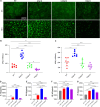The role of cyclic di-GMP in biomaterial-associated infections caused by commensal Escherichia coli
- PMID: 40833985
- PMCID: PMC12367115
- DOI: 10.1371/journal.pone.0330229
The role of cyclic di-GMP in biomaterial-associated infections caused by commensal Escherichia coli
Abstract
Biofilms are protective structures that bacteria use to evade the immune system and resist antibiotics, leading to complications in medical treatments, especially with implanted devices. The molecule cyclic di-GMP (c-di-GMP) is crucial for biofilm formation in Escherichia coli (E. coli). To understand its role in biomaterial-associated infections (BAIs), we created four E. coli strains with varying c-di-GMP levels: a knockout strain (ΔdgcQ), an overexpression strain (OdgcQ), a complemented strain (CΔdgcQ), and a wild-type mutant strain (WT). By employing in vitro BAI models and techniques such as crystal violet (CV) staining, XTT assay, confocal laser scanning microscopy (CLSM), and scanning electron microscopy (SEM), we observed that the ΔdgcQ strain, with low c-di-GMP levels, adhered more readily to biomaterial surfaces at the initial stage of biofilm formation, yet faced difficulties in sustaining mature biofilms. In contrast, OdgcQ and CΔdgcQ with higher c-di-GMP were able to generate more mature biofilms on biomaterial surfaces. Additionally, c-di-GMP was found to negatively regulate bacterial swimming motility and enhance the ability to cope with environmental stresses. The results also reiterate the canonical function of c-di-GMP, which is to reduce the motility of bacteria. Concurrently, gene expression analysis confirmed these findings, revealing that genes related to motility (flhC, flhD, motA, motB, ycgR), extracellular polymeric substances (EPS) synthesis (csgA, csgD, bcsA, ynfM), and stress resistance (sodA, katE, rstA, ibpA, ibpB, hdeA, hdeD, gadA, gadB) were consistently up-regulated in OdgcQ with high c-di-GMP levels. Importantly, ΔdgcQ considerably promoted the adhesion to and invasion of host cells and elicited a stronger host immune response, whereas OdgcQ impaired the ability to interact with host cells, as evidenced by decreased adhesion/invasion and inhibited release of inflammatory cytokines (IL-1β, IFN-β, IP-10, and NF-κB). Collectively, our findings shed light on the c-di-GMP signaling pathway's role in BAIs and propose that modulating this pathway could be a promising strategy for combating E. coli-induced BAIs.
Copyright: © 2025 Li et al. This is an open access article distributed under the terms of the Creative Commons Attribution License, which permits unrestricted use, distribution, and reproduction in any medium, provided the original author and source are credited.
Conflict of interest statement
The authors have declared that no competing interests exist.
Figures







Similar articles
-
Functional analysis of cyclic diguanylate-modulating proteins in Vibrio fischeri.mSystems. 2024 Nov 19;9(11):e0095624. doi: 10.1128/msystems.00956-24. Epub 2024 Oct 22. mSystems. 2024. PMID: 39436151 Free PMC article.
-
The cyclic di-GMP receptor YcgR links the second messenger with the putrescine quorum sensing system in modulation of Dickeya oryzae motility.mBio. 2025 Jul 9;16(7):e0101625. doi: 10.1128/mbio.01016-25. Epub 2025 May 30. mBio. 2025. PMID: 40444987 Free PMC article.
-
Crucial roles of intracellular cyclic di-GMP in impacting the genes important for extracellular electron transfer by Geobacter metallireducens.Appl Environ Microbiol. 2025 Jul 23;91(7):e0072725. doi: 10.1128/aem.00727-25. Epub 2025 Jun 4. Appl Environ Microbiol. 2025. PMID: 40464557 Free PMC article.
-
Management of urinary stones by experts in stone disease (ESD 2025).Arch Ital Urol Androl. 2025 Jun 30;97(2):14085. doi: 10.4081/aiua.2025.14085. Epub 2025 Jun 30. Arch Ital Urol Androl. 2025. PMID: 40583613 Review.
-
Cyclic Diguanylate in the Wild: Roles During Plant and Animal Colonization.Annu Rev Microbiol. 2024 Nov;78(1):533-551. doi: 10.1146/annurev-micro-041522-101729. Epub 2024 Nov 7. Annu Rev Microbiol. 2024. PMID: 39270684 Free PMC article. Review.
References
-
- Mori T, Yamamoto H, Tabata T, Shimizu T, Endo Y, Hanasawa K, et al. A free radical scavenger, edaravone (MCI-186), diminishes intestinal neutrophil lipid peroxidation and bacterial translocation in a rat hemorrhagic shock model. Crit Care Med. 2005;33(5):1064–9. doi: 10.1097/01.ccm.0000162952.14590.ec - DOI - PubMed
MeSH terms
Substances
LinkOut - more resources
Full Text Sources
Medical

